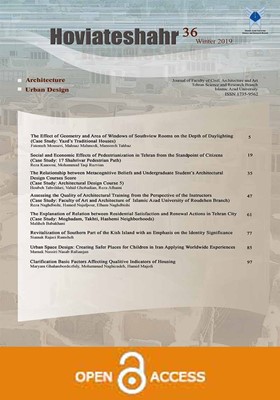-
-
List of Articles
-
Open Access Article
1 - Social and Economic Effects of Pedestrianization in Tehran From the standpoint of citizens (Case Study: 17 Shahrivar Pedestrian path)
رضا کانونی محمدتقی رضویان -
Open Access Article
2 - The Effect of Geometry and Area of Windows of Southview Rooms on The Depth of Daylighting (Case Study: Yazd’s Traditional Houses)
fatemeh mousavi mahnaz mahmodi mansoreh tahbaz -
Open Access Article
3 - The Relationship between Metacognitive beliefs and undergraduate student’s architectural design courses score (Case study: Architectural design 5 students)
houbeh tahvildari vahid ghobadian Reza Afhami -
Open Access Article
4 - Evaluating the quality of architectural training from the perspective of the instructors (Case Study: Faculty of Art and Architecture, Islamic Azad University, Roudehen Branch)
Reza Naghdbishi Hamed Najafpour الهام نقدبیشی -
Open Access Article
5 - The explanation of Relation between Residential Satisfaction and renewal actions in Tehran city (Moghadam, Takhti, Hashemi Neighborhoods)
maliheh babakhani -
Open Access Article
6 - Clarification of principle’ s factors to contributing of housing quality indexes
Maryam Ghalambordezfuly mohammad naghizadeh hamid majedi -
Open Access Article
7 - Revitalization of Southern Part of the Kish Island with an Emphasis on the Identity Significance
siamak Rajaei Ramsheh -
Open Access Article
8 - Urban Space Design: Creating Safer Places for Children in Iran Applying Worldwide Experiences
Mamak Nassiri Nasab Rafsanjani
-
The rights to this website are owned by the Raimag Press Management System.
Copyright © 2021-2025







